
A revolver is a repeating handgun that has at least one barrel and uses a revolving cylinder containing multiple chambers for firing. Because most revolver models hold up to six cartridges before needing to be reloaded, revolvers are also commonly called six shooters.

The Smith & Wesson Model 1006 is a recoil operated double-action/single-action semi-automatic handgun chambered in the 10mm Auto cartridge manufactured by Smith & Wesson.
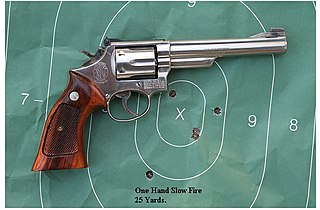
The Smith & Wesson Model 19 is a revolver produced by Smith & Wesson that was introduced in 1957 on its K-frame. The Model 19 is chambered for .357 Magnum. The K-frame is somewhat smaller and lighter than the original N-frame .357, usually known as the Smith & Wesson Model 27. A stainless steel variant of the Model 19, the Smith & Wesson Model 66, was introduced in 1971.

The Smith & Wesson Model 686 is a six- or seven-shot double-action revolver manufactured by Smith & Wesson and chambered for the .357 Magnum cartridge; it will also chamber and fire .38 Special cartridges. Smith & Wesson introduced the Model 686 in 1981. It is the stainless steel version of the Model 586, which featured a blued steel finish. They are available ported and unported with a choice of 6- or 7-round cylinders.

In American English, a pocket pistol is any small, pocket-sized semi-automatic pistol, and is suitable for concealed carry in a pocket or similar space.

The Smith & Wesson Model 15, initially the Smith & Wesson K-38 Combat Masterpiece, is a six-shot double-action revolver with adjustable open sights produced by Smith & Wesson on the medium-size "K" frame. It is chambered for the .38 Special cartridge and is fitted with a 4-inch (100 mm) barrel, though additional barrel options have been offered at various times during its production. It is essentially a shorter barrel version of the Smith & Wesson Model 14 and an adjustable-sight version of the seminal Smith & Wesson Model 10 with target shooting features.
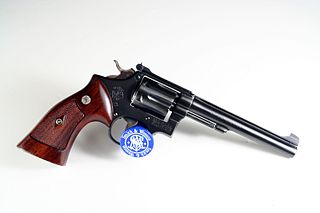
The Smith & Wesson Model 17 is a six-shot double-action revolver chambered for .22 LR. It is built on Smith & Wesson's medium-sized K-frame.
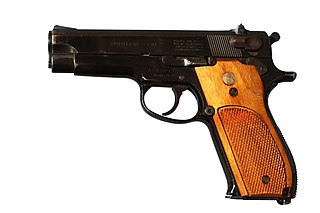
The Smith & Wesson Model 39 is a semi-automatic pistol developed for the United States Army service pistol trials of 1954. After the Army abandoned its search for a new pistol, the Model 39 went on the civilian market in 1955 and was the first of Smith & Wesson's first generation semi-automatic pistols. A modified version saw limited use with Naval Special Warfare units as the Mk 22 Mod 0.

The GP100 is a family/line of double action five-, six-, seven-, or ten-shot revolvers made by Sturm, Ruger & Co., manufactured in the United States. Since its introduction, it has been produced with a number of variations including various barrel lengths and profiles, fixed or adjustable sights, and in blued carbon steel or stainless steel.

The S&W Model 4006 is a semi-automatic handgun introduced by Smith & Wesson on January 17, 1990 along with the new .40 S&W cartridge. It is a 3rd-generation S&W pistol.
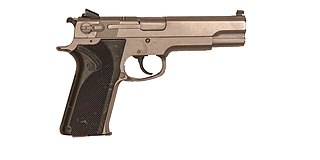
The Smith & Wesson Model 4506 is a third-generation semi-automatic pistol from Smith & Wesson's 4500 series of handguns. The 4506 is chambered for the .45 ACP cartridge and, with the purchase of special springs, the stronger .45 Super. It is constructed almost entirely from stainless steel and is thus extremely resistant to harsh weather conditions. The 4506 is a traditional double-action/single-action pistol. The first shot is fired in double-action mode. Each subsequent shot is fired in single-action mode. It features one-piece Xenoy wrap-around grips with either a curved or straight back strap. The 4506 was produced from 1988 to 1999.

A snubnosed revolver is a small, medium, or large frame revolver with a short barrel, generally less than 4 inches in length. Smaller such revolvers are often made with "bobbed" or "shrouded" hammers and there are also "hammerless" models ; the point is to allow the gun to be drawn with little risk of it snagging on clothing. Since the external movement of the mechanism is minimal or nil, shrouded and hammerless models may be fired from within clothing. The design of these revolvers compromises range and accuracy at a distance in favor of maneuverability and ease of carry and concealment.

The Smith & Wesson Model 457 is a compact semi-automatic pistol from Smith & Wesson's Third Generation series of alloy and steel-framed handguns in company's Value Line of budget-priced auto pistols. The 457 is a compact pistol chambered for the .45 ACP cartridge. The design utilizes a double-action/single action trigger mechanism, meaning that the first shot is fired with long double-action pull, with following shots fired in single-action. The 457's external hammer omits a thumb spur, thereby reducing the risk of being caught on clothing during unholstering. A slide-mounted safety lever that drops the hammer from its cocked position when moved to the 'safe' position. The 457 has a 95 mm (3.75 in) barrel and 7-round magazine capacity. The Model 457 was produced with a matte-finish carbon steel slide and blackened aluminum alloy frame. Other versions include the Model 457S with a stainless steel slide and aluminum frame, and the Model 457TDA with a satin-finished aluminum frame and black carbon steel slide.

The Smith & Wesson M&P is a polymer-framed, short recoil operated, locked breech semi-automatic pistol introduced in the summer of 2005 by the American company Smith & Wesson. It uses a Browning-type locking system. While targeted at law enforcement agencies, the M&P is also widely available on the commercial market.

A handgun is a firearm designed to be usable with only one hand. It is distinguished from a long gun which needs to be held by both hands and braced against the shoulder. The two most common types of handguns are revolvers and semi-automatic pistols, although other types such as derringers and machine pistols also see infrequent usage.
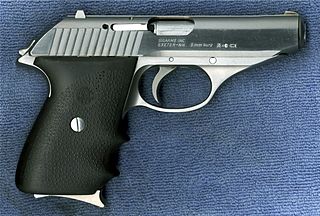
The SIG Sauer P230 is a small, semi-automatic handgun chambered in .32 ACP or .380 Auto. It was designed by SIG Sauer of Eckernförde, Germany. It was imported into the United States by SIGARMS in 1985. In 1996 it was replaced by the model P232.
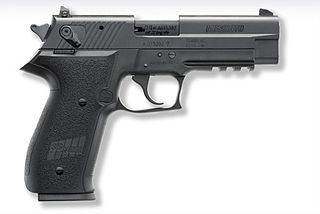
The SIG Sauer Mosquito is a blowback-operated, semi-automatic pistol aesthetically based on the SIG Sauer P226, but 10% smaller in size and chambered for the .22 LR cartridge. The pistol is manufactured with an aluminum-zinc alloy slide and polymer frame. The controls are similar to those present on full-size models and include a left takedown lever, a left decocking lever, reversible magazine catch and ambidextrous manual safety. In addition, the pistol is provided with an integral safety lock located at the rear of the magazine well which when enabled prevents cycling of slide, hammer fall, and trigger action. The pistol is available in five different configurations: Standard model, Sport, Threaded barrel, Two-tone, Reversed two-tone, and four special editions having different colors.
The Smith & Wesson 645 and Smith & Wesson 745 are second-generation semi-automatic pistols which predate Smith & Wesson's 4500 series of handguns. The S&W 645/745 is chambered for the .45 ACP cartridge. The S&W 645 is constructed almost entirely from stainless steel and is thus extremely resistant to harsh weather conditions, whereas the S&W 745 has a stainless steel frame and a blued carbon steel slide. The S&W 645 was introduced in 1985 and discontinued in 1988. The S&W 745 was produced from 1986 to 1990, primarily as a single-action competition gun for IPSC shooting.

The Smith & Wesson Bodyguard is a family of small J-frame revolvers with shrouded hammers manufactured by Smith & Wesson. They are available chambered in either .38 Special or .357 Magnum.
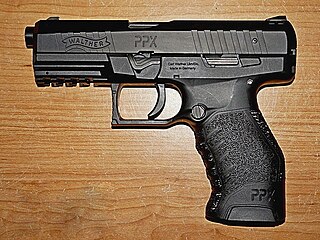
The Walther PPX and the Walther Creed semi-automatic pistols were developed by the German company Carl Walther GmbH Sportwaffen of Ulm as low-cost duty handguns. The PPX was available in 9×19mm Parabellum and .40 S&W. Its successor, the Creed, was available only in 9mm.



















